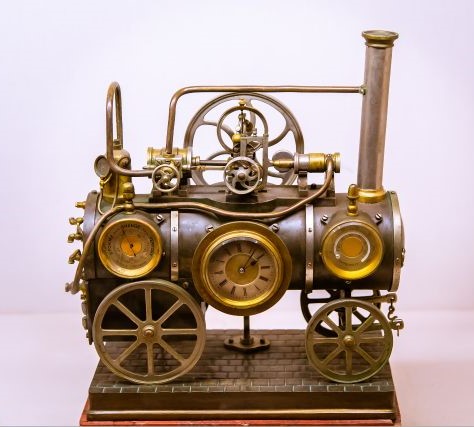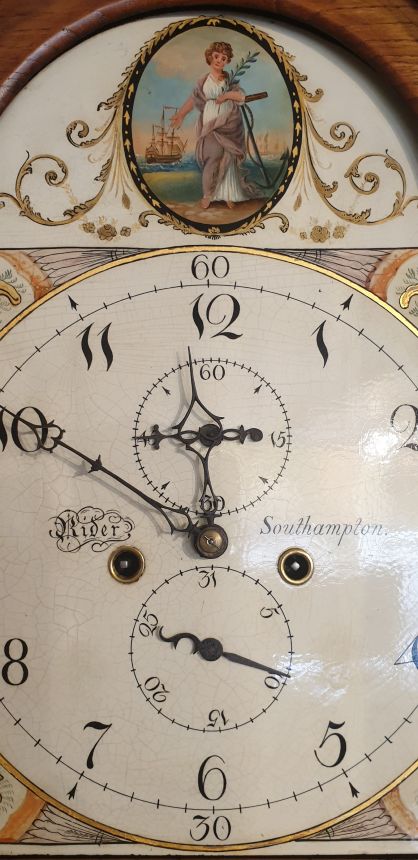Valuations highlight the plight of the general antique clock
Antique clock valuations reveal, that the comforting tick tock … tick tock that accompanied the lives of previous generations is becoming a fading memory. A fact that is supported by the current values achieved for general longcase, mantle, wall and decorative French clocks, which are at their lowest levels since the 1970s. Loss of appeal due to changing habitat is mostly to blame – acres of Victorian patterned wallpaper that used to be the preferred resting place of dial or wall clocks have been torn down; the chiffoniers that supported sleek Edwardian balloon clocks have dwindled in number, and novelty continental time-pieces that once sat upon the shelves of countless antique display cabinets have been made homeless. Our indifference towards what is now seen as lower-value antique clocks has resulted in a glut on the market, keeping prices suppressed. With little indication that interior designers are about to embrace the period excesses of the 1980s, the trade has become more selective and in step with 21st Century trends.

This re-evaluation has meant an owner’s initial investment can no longer be guaranteed, and previously held notions of worth may need to be forgotten. Whether you are a representative of an estate or institution, a private individual or an owner of a business, antique clock valuations along with help and advice can be requested via our contact page.
Which old clocks do we still value, and which are keeping time with our lifestyle?
A traditional antique clock by a desirable maker, epitomizing the highest quality of craftsmanship, design, and technical advancement for the period of manufacture, will still generate interest from the remaining collectors and investors across the globe. For example, the rarest 18th Century twin fusee bracket or table clocks in untouched original condition, still justify six-figure valuations. The finest marine chronometers and floor standing or wall hanging regulators, where their movements meet the precision desired by the trade, are also deemed to be within this select category. However, as generations move on, so does their period of interest, and with it, the focus of the majority of the trade.
The visual and decorative appeal of advanced design, engineering, and innovation found in many 20th Century industrial, commercial and mid-century clocks now has a far greater and widespread appeal. Fortunately, our specialist has considerable knowledge of manufacturers from this period such as Jaeger- LeCoultre, Omega, Synchronome, Percival Arthur Bentley and Angelus.
Requests to value period clocks for insurance, probate, and tax purposes are still in the majority, although, we are increasingly being asked to appraise examples from the 20th Century.
Striking a positive note in today’s market
Our valuations specialist will always draw an owner’s attention to a clock, antique or contemporary, that has commercial appeal. Here are a few examples that they especially keep a look out for –

Industrial clocks are often working miniature engineering wonders and can take many forms, such as locomotives, ships, steam engines and water wheels. Predominantly manufactured in France in the late 19th Century, they have become highly desirable. Wealthy Russian collectors look to acquire rare and singularly different examples. Currently, with an entry-level industrial clock fetching £1500 and rising to £40,000 for more elaborate examples, there are just enough coming onto the market to keep potential customers interested.
Electric clocks were first introduced in Britain in 1840 by Alexander Bain and his partner, the chronometer maker John Barwise. Early examples are now very desirable and are highly sought after. This is again partly due to their cross-over appeal within the interior design-driven market. Often their attractive high quality but simply designed cases belie an industrial-styled interior. Add their scarcity to the equation and you have a potent combination, one that can stimulate avid collectors here in the UK and in the USA to pay £30,000 for the very best examples.
Novelty clocks unlike their industrial counterparts have been produced in many different localities throughout the world, with varying degrees of long-term appeal. Production line models such as those manufactured in the USA and Europe in the late 19th Century are now seen as entry-level purchases amongst collectors and dealers. However, novelty clocks that combine a good quality mechanism and fine craftsmanship within a clever design have greater widespread appeal and value.
Values at auction can rocket when a novelty clock, quite possibly created on a whim by a skilled craftsman, is of a form and size that has a crossover appeal amongst dealers, decorators, and collectors from around the world. In such cases, the quality of the mechanism is less important than its overall decorative look.

When size and complexity really matters
If they are of very high quality and have desirable technical advancements, such as striking twin gongs, antique carriage clocks have also retained their value and place on collectors’ shelves. Skilfully crafted and decorated (enamelled) miniature cases that house complex movements are highly sought after.
Does the cost of maintaining antique clocks often exceed their value?
Yes, the cost of repair or servicing may currently exceed their open market value or even their retail price ticket, especially for lower-value antique clocks. However, if carried out by an experienced horologist,, they should continue to provide accurate time keeping and pleasure for many years. Please visit our dedicated restoration page for more information.
Valuations show that antique clocks were at the height of their popularity during the latter part of the 20th Century. As trends often repeat themselves, well-maintained examples may well be of a premium in the not-so-distant future.
Living with a grandfather
There is no denying, that longcase or grandfather clocks make their presence known. Owing to their historic appearance and sound, incorporating them within contemporary interiors can be a challenge. They also take a little time, patience, and a degree of expense to enable them to keep functioning. However, when restraint has been shown in their original design, we think the skill and artistry of the cabinet maker, horologist, dial maker and painter can often combine to create a unique, decorative and much loved focal point within the home – qualities that have increasingly been mentioned by new owners and visitors to our showroom, in Dorking, Surrey. It is hoped that this is indicative of a revival in interest in acquiring antique grandfather clocks and, consequently, that it will not be long before we start, once again, valuing such items. With the market at its lowest, it is certainly the right time to invest.

What’s the cost of an unrestored entry-level longcase clock?
A well proportioned 200-year-old mahogany and oak eight-day duration country longcase clock with a painted dial, and requiring restoration used to be valued at £800-£1200. Antique clock valuations now report them to be worth as little as £100-£300. It has never been so affordable to purchase a piece of social history. Numerous auctions are held daily and bidding online is relatively easy. The potential reward for a few hours of searching is securing a longcase clock by a local maker. Remember to always ask for condition reports and request that the saleroom includes as many photographs as possible.
If you would prefer to be guided by a specialist, then contact Culvertons as we would be happy to act on your behalf. Our experience and contacts are at your disposal. Selecting a superior clock from the many hundreds on offer and arranging for its transportation, restoration and installation are just a few of the services we can provide.
Antique clock valuations – why request our services?
Our specialist will help clients navigate through this selective market with discretion and impartiality. They will identify clocks that have appeal and, if requested, give advice as to the most cost-effective route to take to maximise the revenue from their sale. Executors, administrators and estate representatives entrusted with antique clocks can feel confident that Culvertons will prepare a valuation report for submission to HMRC in a professional and sensitive manner.
Our valuation, restoration and advisory services are also available to private individuals and businesses. If you possess a collection or a single-time piece and would like to find out their value for financial protection purposes, please contact us.
Do we offer this service in your area?
Culvertons will undertake antique clock valuations throughout central & southern England principally in Surrey, Kent, Sussex and Hampshire, including London.
How do I arrange a quotation?
If you require a quotation or more information about valuing antique clocks, some help and advice, or would like to send us an image please visit our contact page.

